Eastern PEI – Some Random Ramblings
This is my fourth post from a recent visit to Prince Edward Island and will feature a number of places Alison and I visited between and after golf games at the two Brudenell River courses. We started the day with a 7:00 tee time at Dundarave which I described in this hole-by-hole post. Finishing just after 10:00 we had lots of time to start exploring eastern PEI after freshening up at Brudenell Fairways Chalets where we were staying for two nights. Please join us as we check out Georgetown, Souris, Basin Head and East Point Lighthouse, but first we need a bite to eat.
Clam Digger’s Restaurant
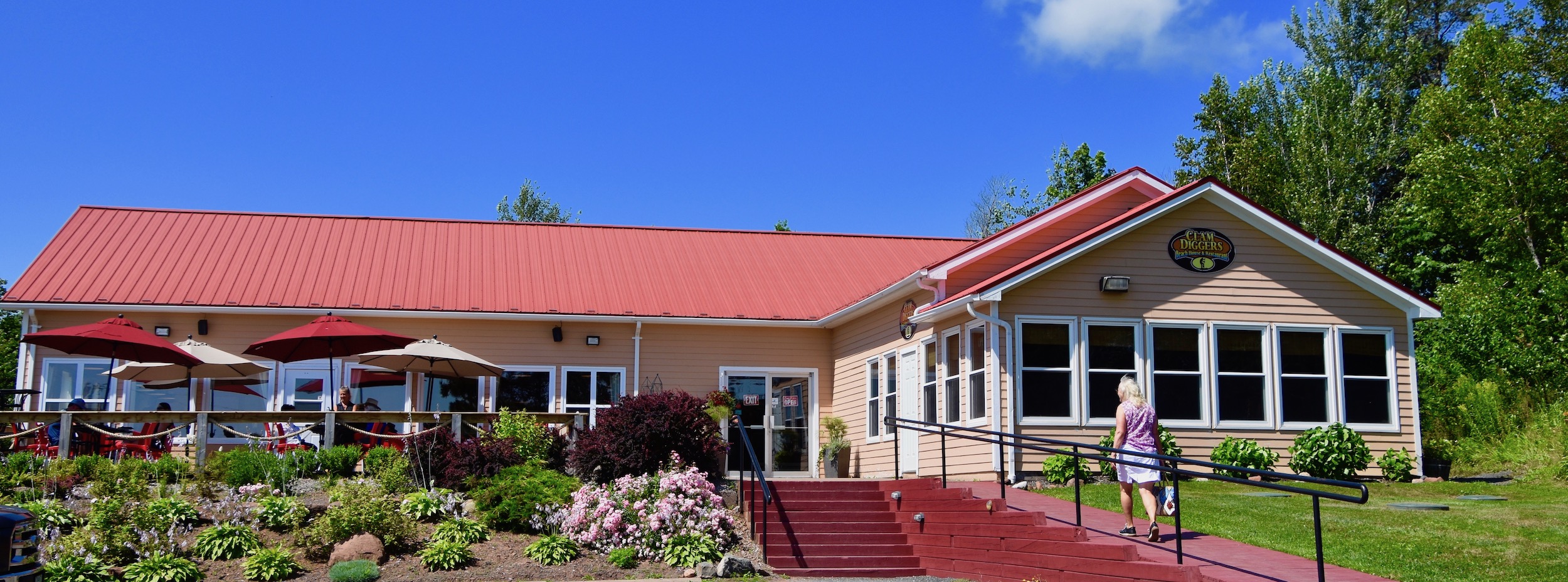
Given our early tee time we had not had breakfast and were ready for an early lunch. Friends of ours who have a summer home in eastern PEI recommended Clam Digger’s Restaurant in nearby Cardigan so we opted to give it a try. Despite being just around noon the parking lot was almost full which is usually a good sign. This place used to be in Georgetown. but a few years ago moved to this new building which has a pleasant view of Cardigan harbour from almost every table.
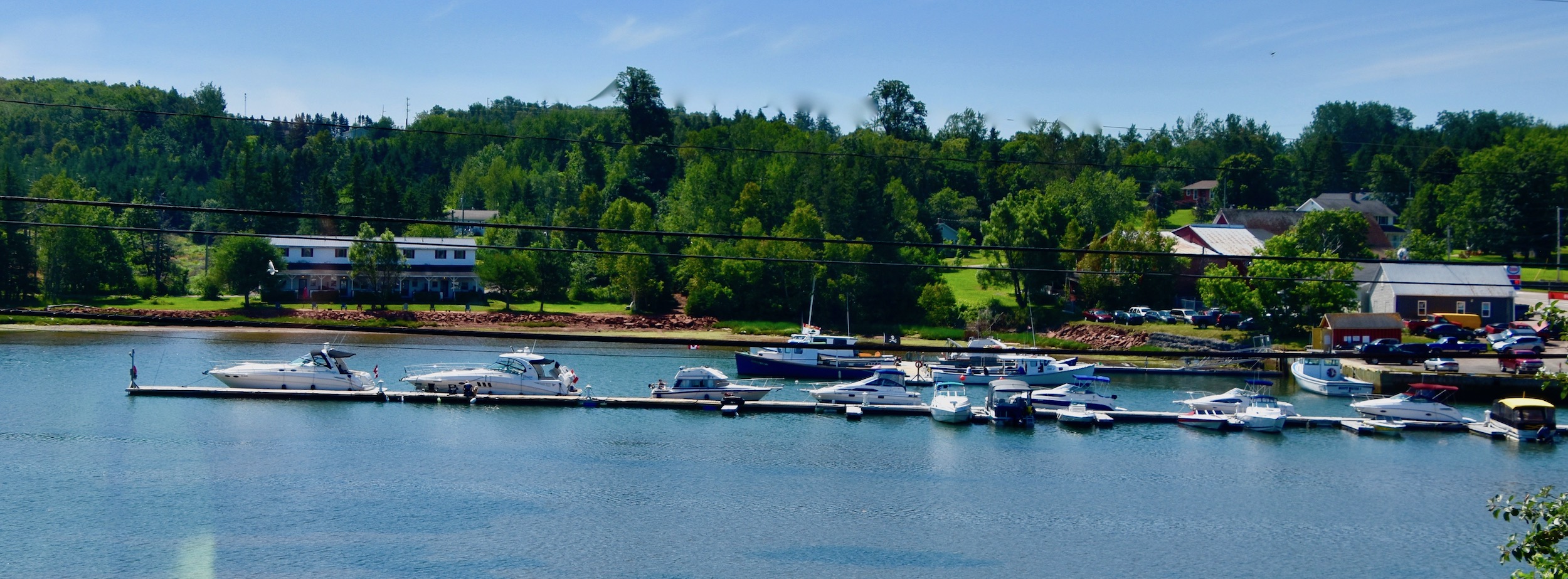
Prince Edward Island is justly famous for its great variety of seafood, particularly shellfish including lobster, scallops, snow crab, oysters, mussels and of course, clams. When I first started coming to the island many, many years ago, almost everything was deep fried and the ‘seafood platter’ was considered the ultimate showcase for PEI products from the sea. I’m glad to say that those days are long gone and places like Clam Digger’s offer their seafood in many different ways. Yes, you can still get deep fried fish and chips which is a guilty pleasure for sure, but for this meal I opted for the much more healthy seafood stew which contained all of the shellfish listed above except snow crab plus haddock. Absolutely delicious.
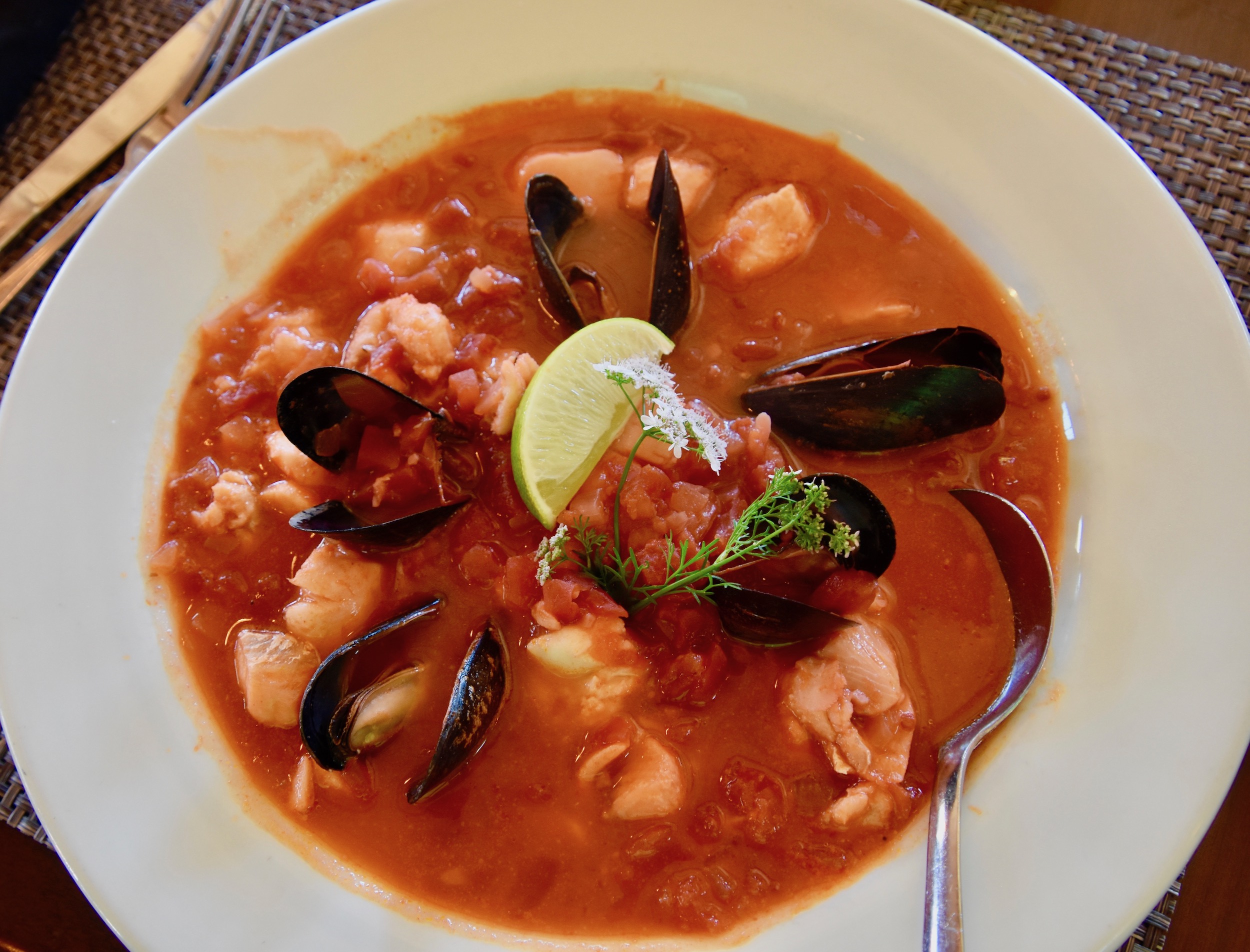
Alison opted for the haddock tacos which are one of the specialties of the house and from what I could see on other tables, a very popular choice.
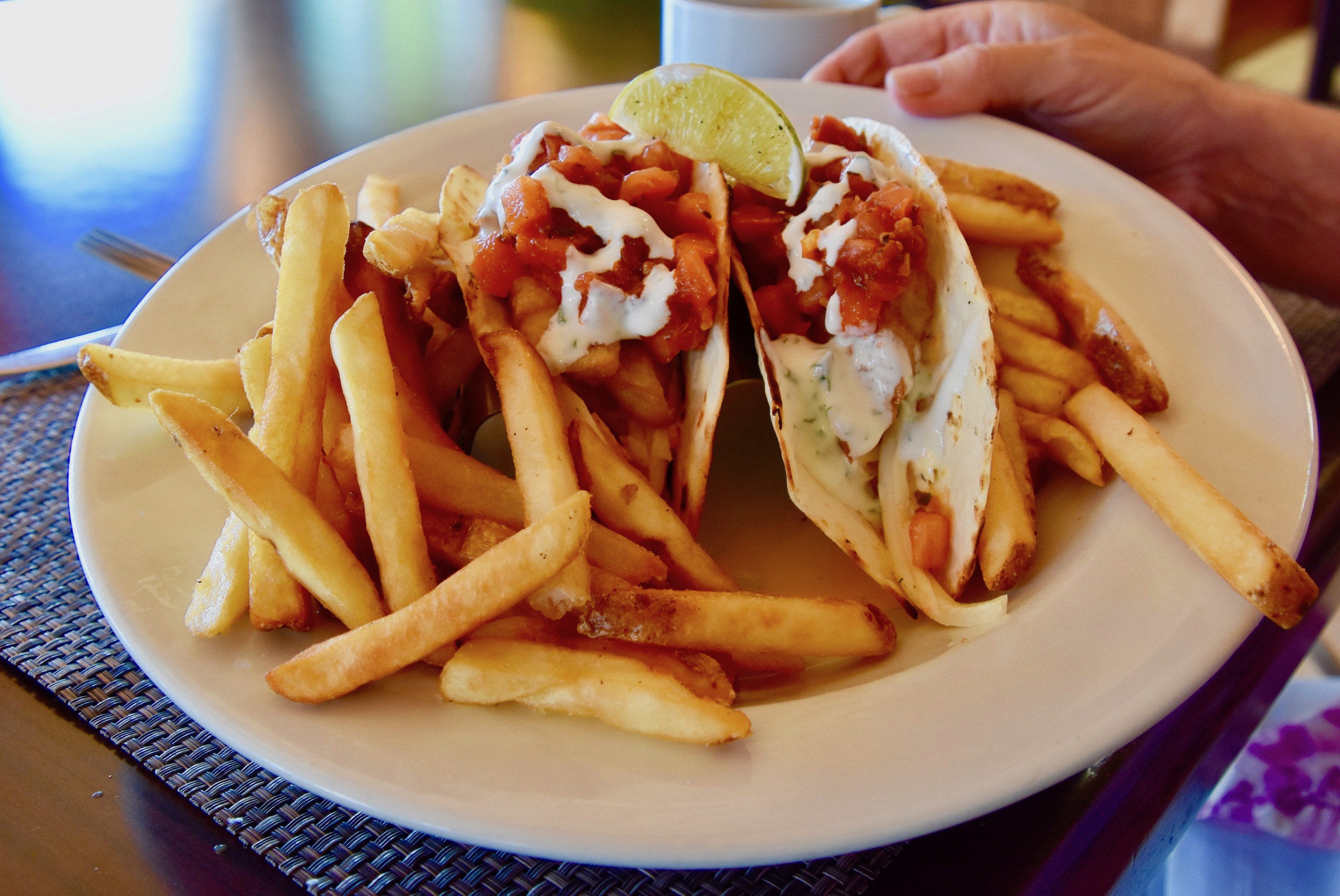
While Alison stuck with ice water I could not resist one of the fine beers from PEI’s most famous craft brewery, Gahan which has become so popular that they now have five Gahan House pubs throughout the Maritimes.
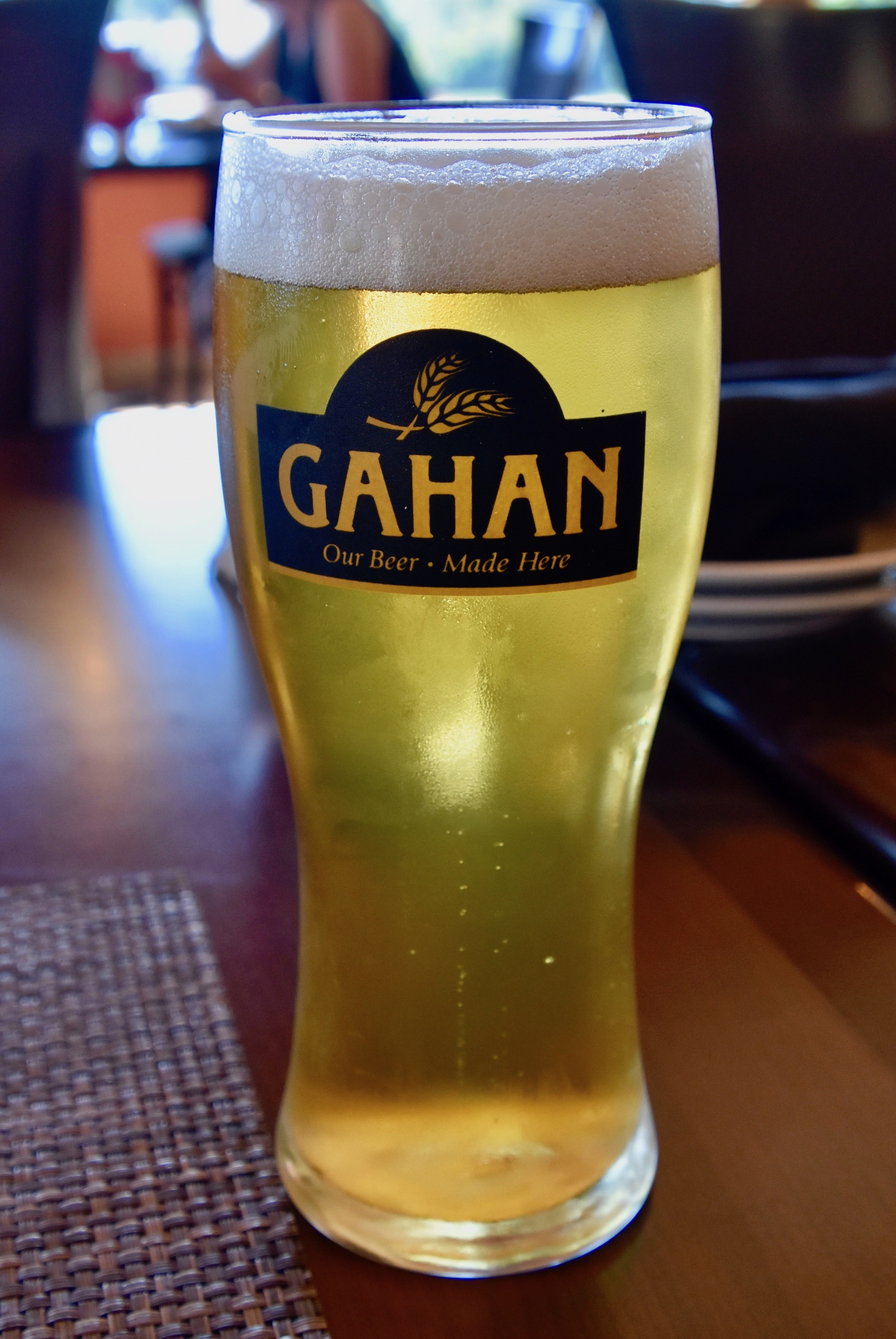
Our stomachs filled we were set to start exploring eastern PEI starting with Georgetown.
Georgetown Gardens
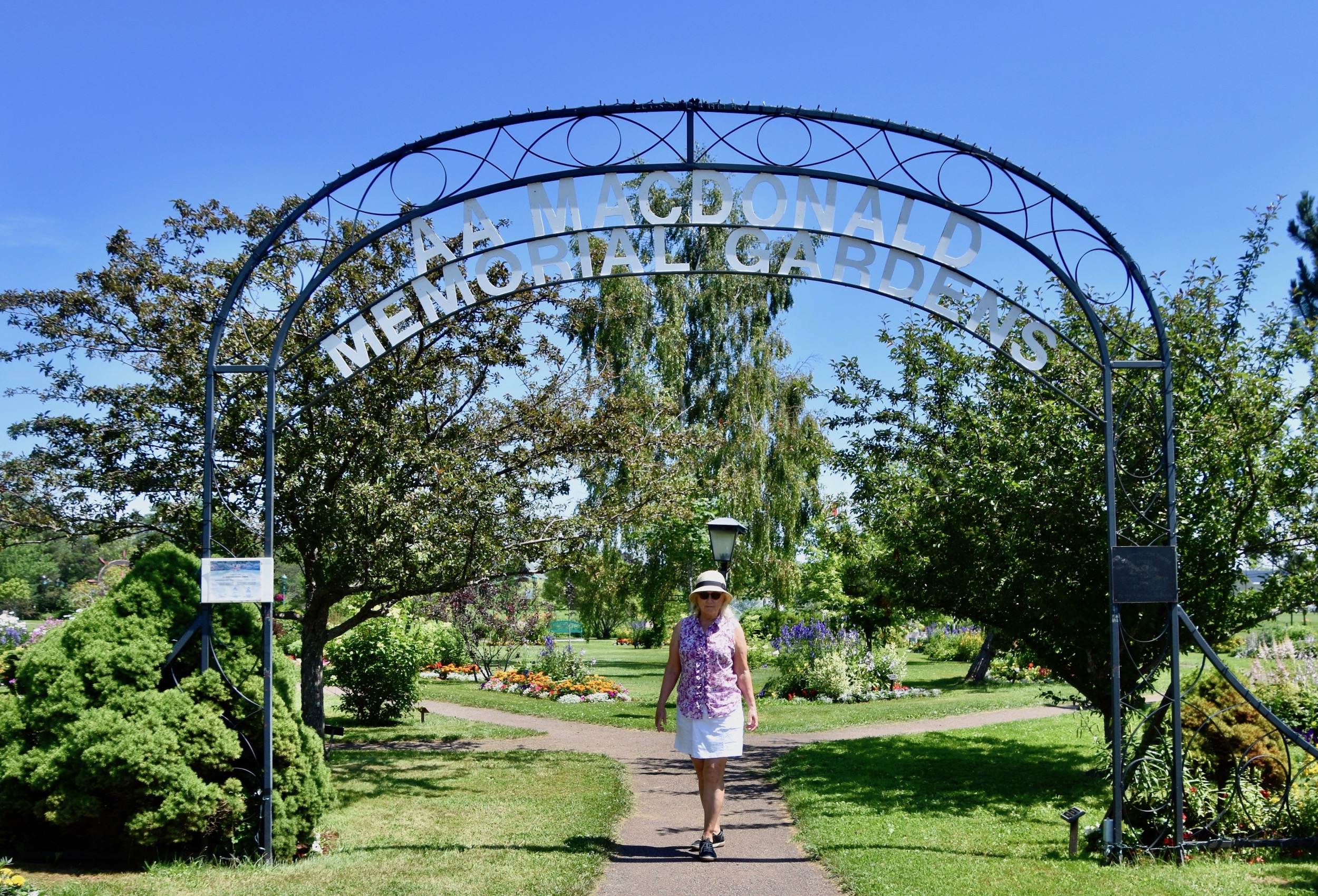
The A.A.MacDonald Memorial Gardens or just the Georgetown Gardens as most people call it, is the largest municipal garden in all of Prince Edward Island which is quite a feat for a place that has only 555 residents. Georgetown is one of eastern PEI’s prettiest little towns with a location at the end of a peninsula with the Cardigan River to the north side and the confluence of the Brudenell and Montague Rivers to the south. In 2018 this area, which includes Georgetown, Montague, Cardigan and other smaller communities were amalgamated into the town of Three Rivers.
The gardens are quite spacious with a location between the handsome Georgetown Courthouse, the King’s Playhouse and Trinity Anglican Church which dates back to 1839. It’s definitely worthwhile to park your vehicle and get out and take a stroll around this place. It is called a memorial garden because each of the sixty plus small plantings are dedicated to a specific family or person. Here’s one example.
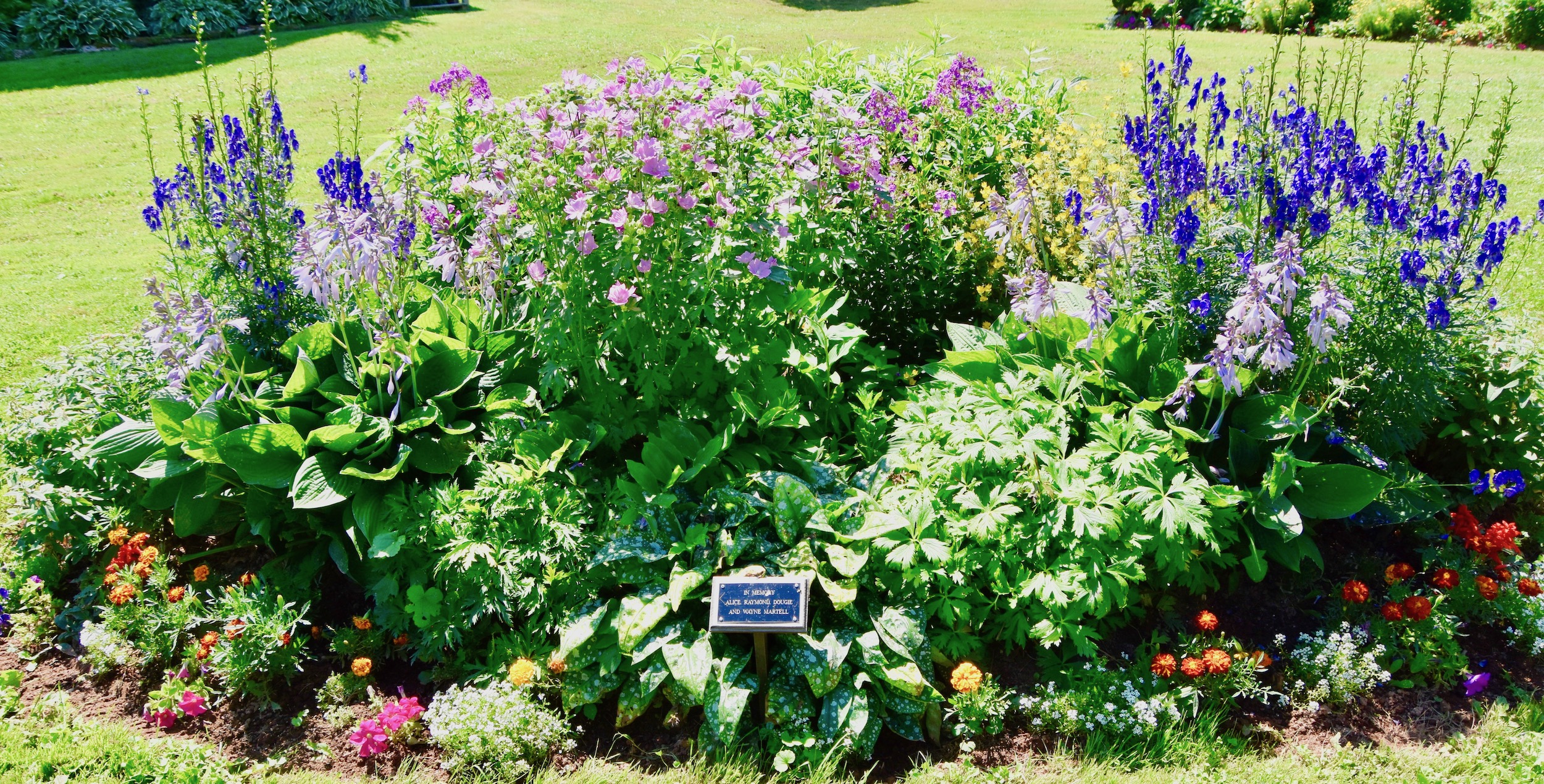
I love exploring gardens like these because it inevitably leads to new ideas for plantings in my own gardens in St. Margaret’s Bay.
There is a new fountain in the gardens that reminds me of a giant sprinkler as it spreads water in a helical pattern that is quite fascinating to watch.
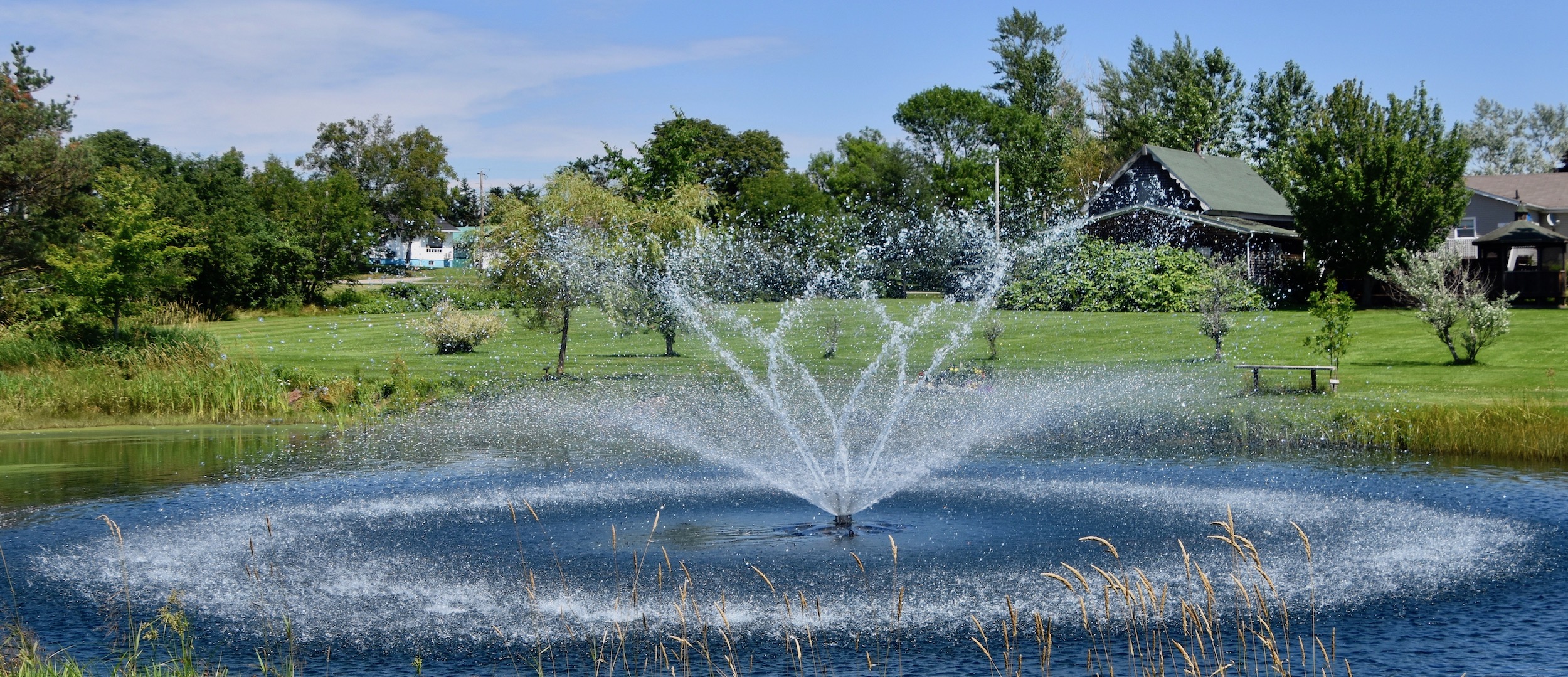
And of course you can’t miss the largest ship wheel in Canada.
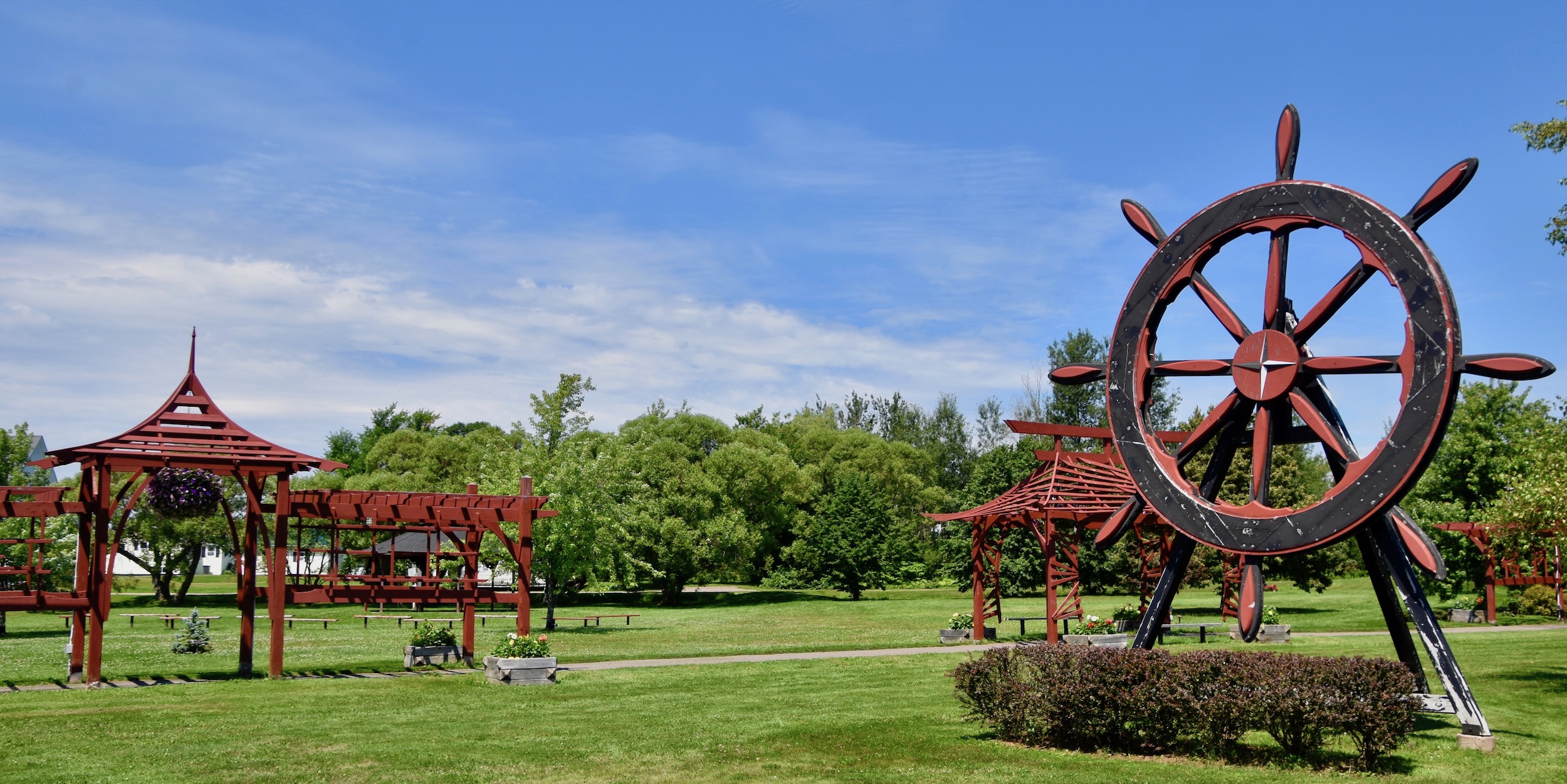
Souris, Eastern PEI
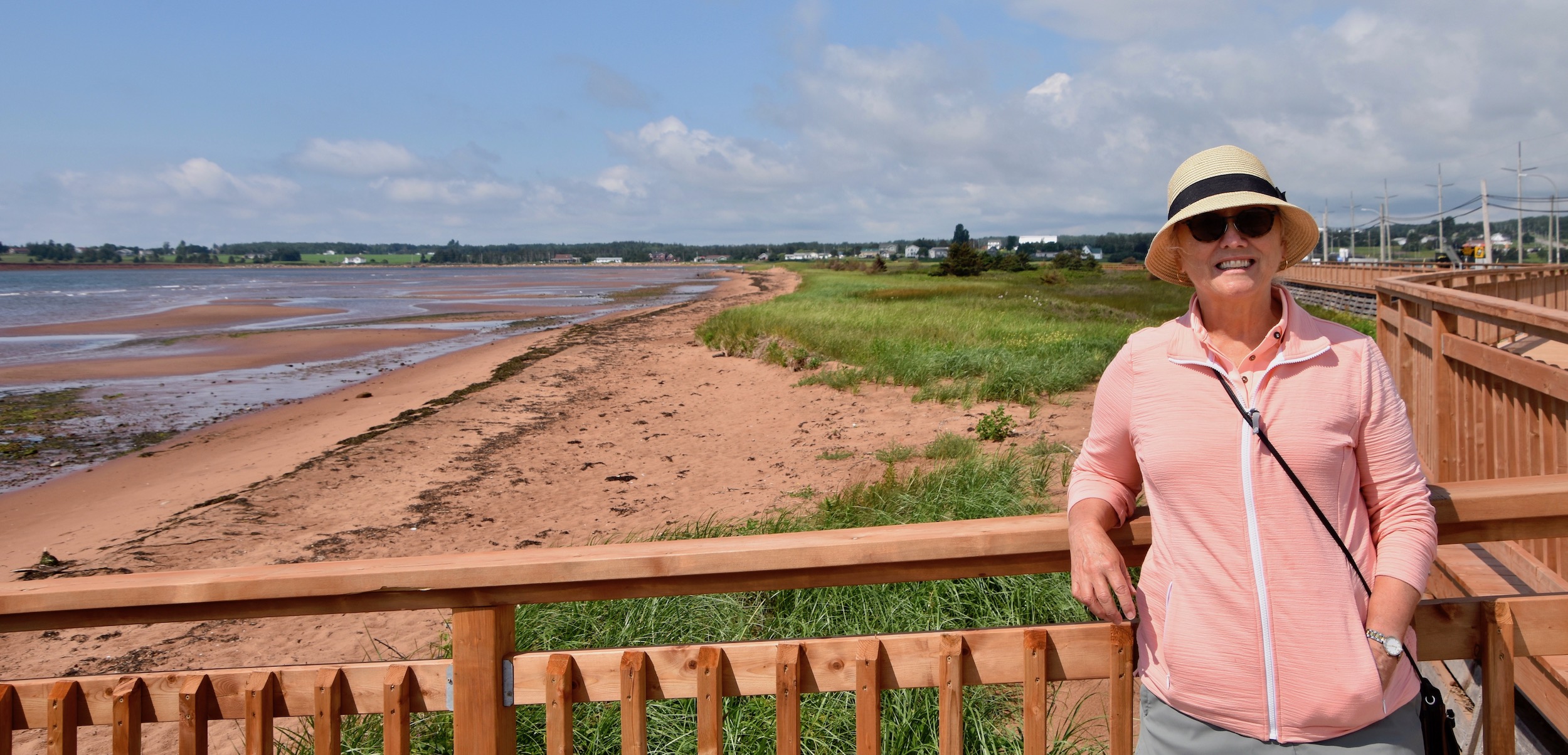
From Georgetown we headed a short distance west to pick up Route 4, the main road in eastern PEI heading for Souris, the largest town in this part of the province. I had been here years ago to take the ferry to the Magdalen Islands to write my first story for Saltscapes magazine, but had not spent any time exploring the place. Approaching from the south side you cannot help but notice the boardwalk which is part of South Beach Gateway Park and it beckons you to stop and walk the length and back. There is a great view of Souris beach which while not the greatest for swimming is great for digging clams or searching for beach glass, both of which a number of people were doing.
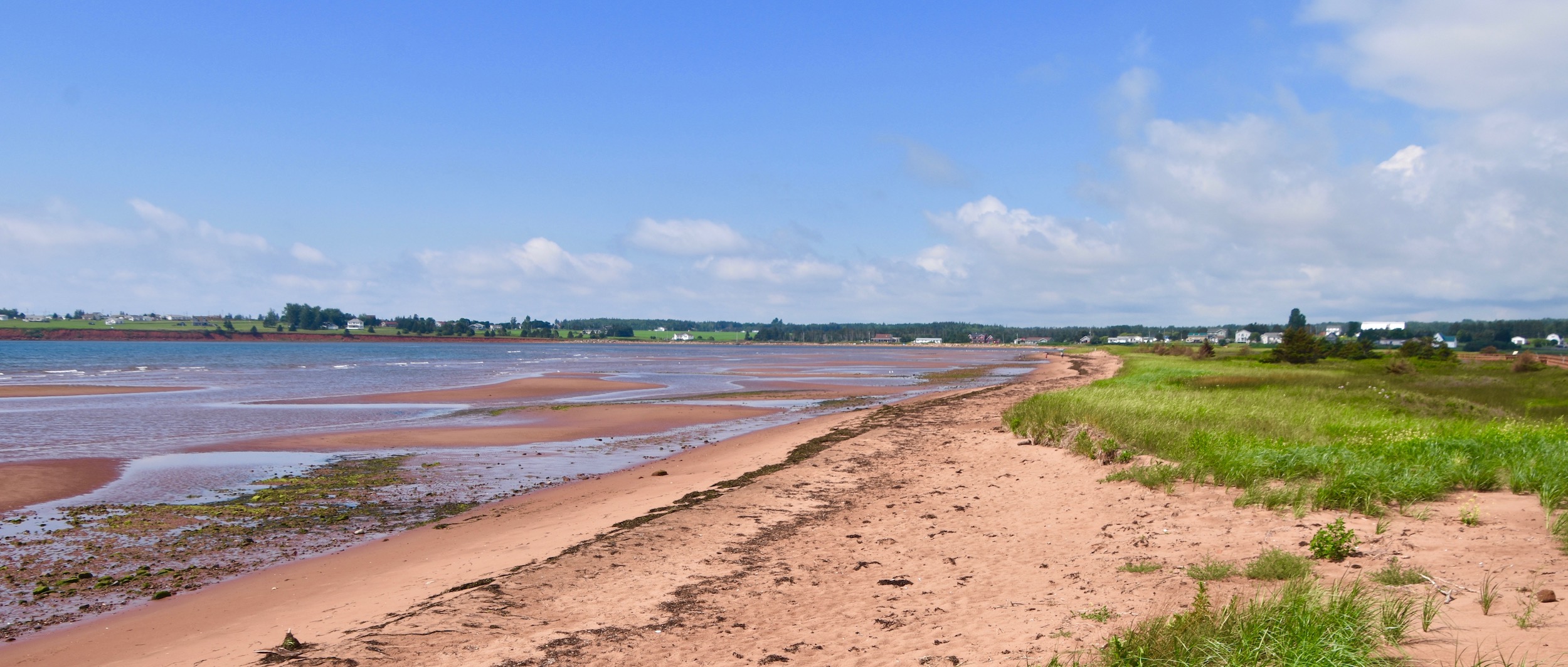
This type of habitat is also great for birding with many varieties of shorebirds, gulls, terns and smaller birds that nest in the grass like this very curious savannah sparrow that sat on the rail not more than a few feet away.
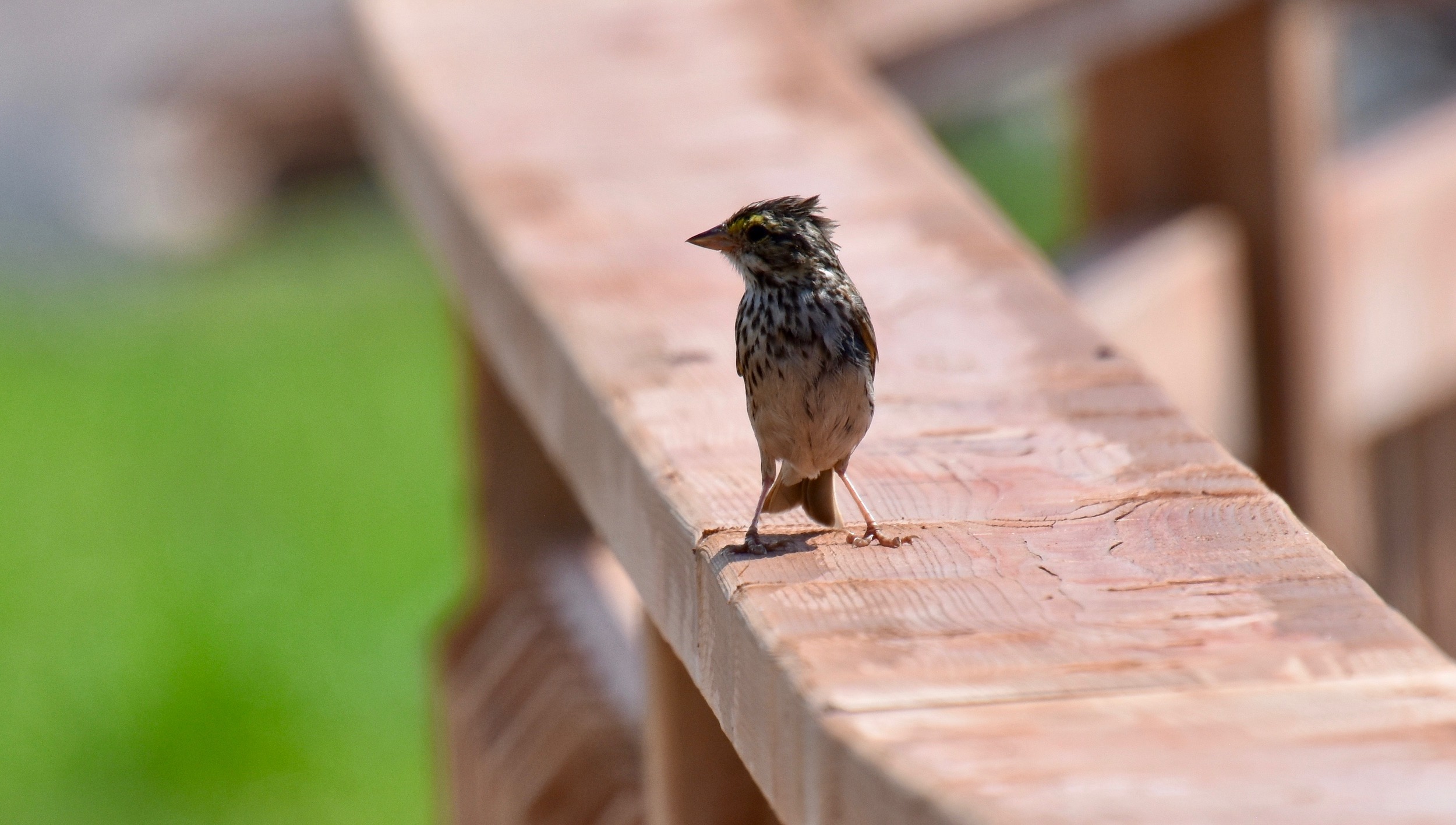
There are a number of small businesses on the boardwalk offering food, souvenirs and handicrafts. Although it was only a few hours after our lunch, we could not pass up sampling something from the Lobster Shack.
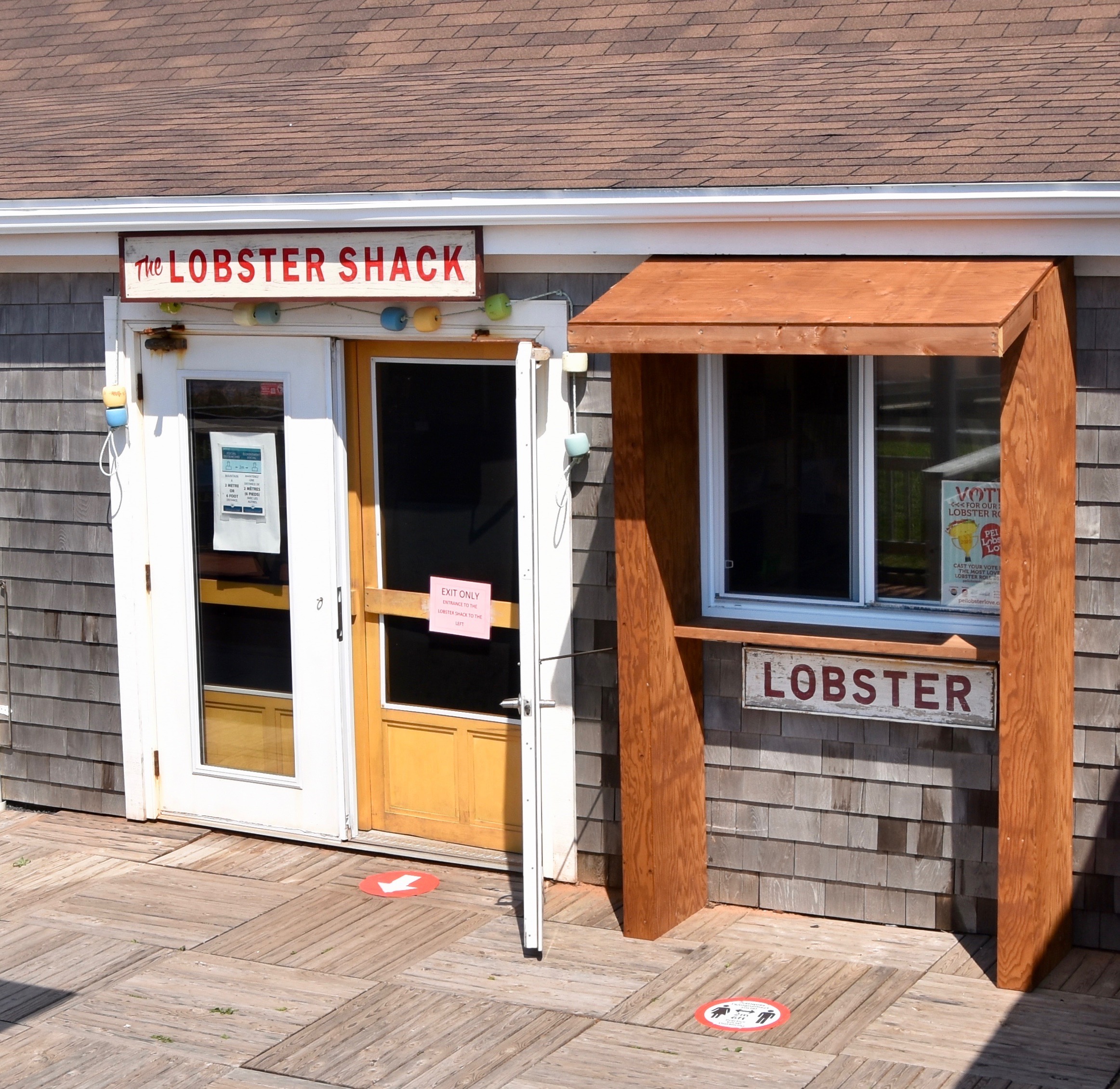
PEI has an ongoing contest as to which place serves the best lobster rolls and we had heard that the Lobster Shack was in the running so we ordered one to split as well as a half dozen Colville Bay oysters which are harvested not more than a few miles from this very spot.
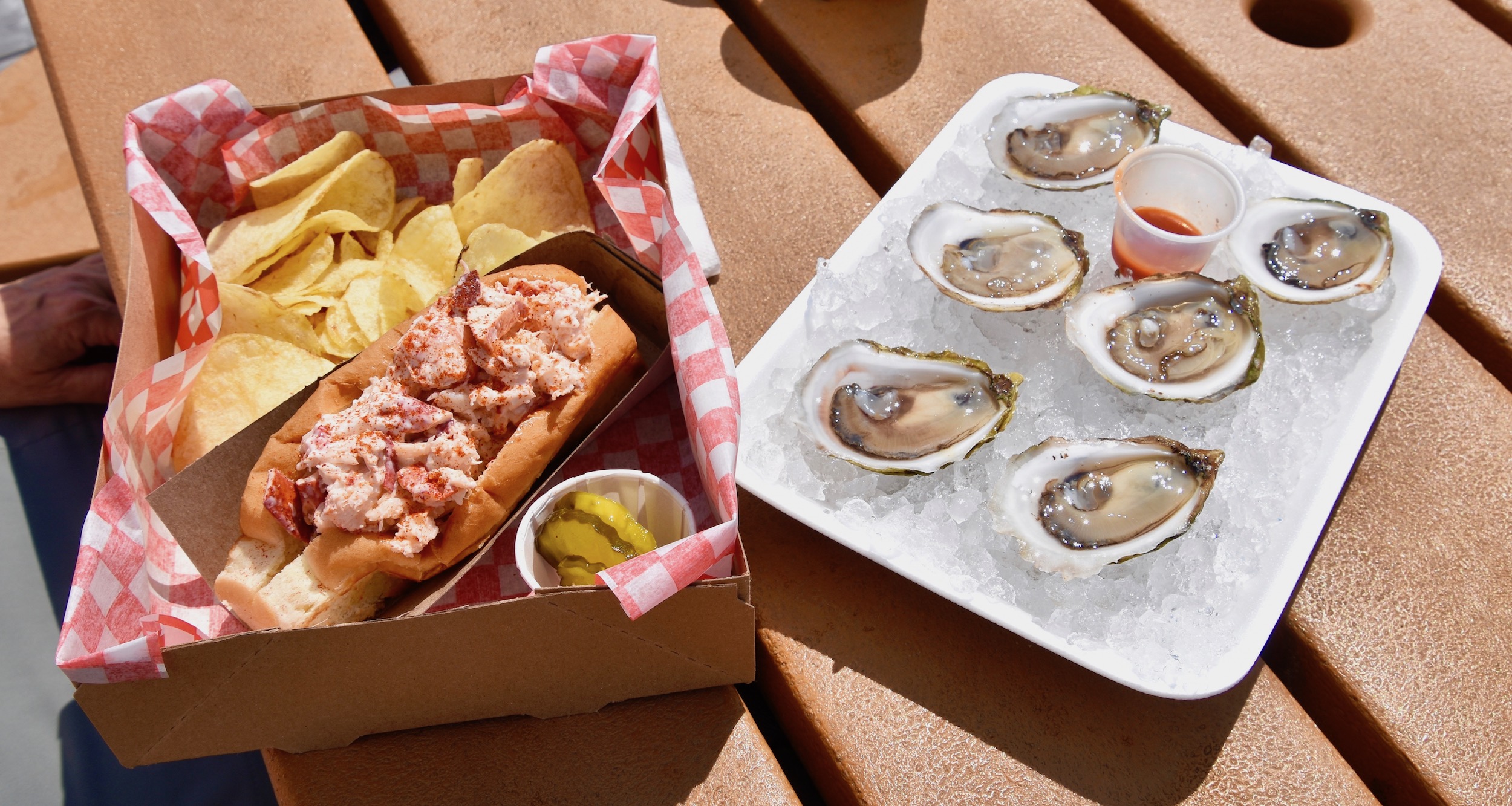
We enjoyed our food on a picnic table while staring out at the waters of Colville Bay. The lobster roll was as good as advertised and I absolutely love fresh shucked oysters with lemon juice and a touch of hot sauce. Sitting here in the afternoon sun this really felt like we were seeing and eating the best of what eastern PEI has to offer, but there was much more to explore.
Souris Lighthouse
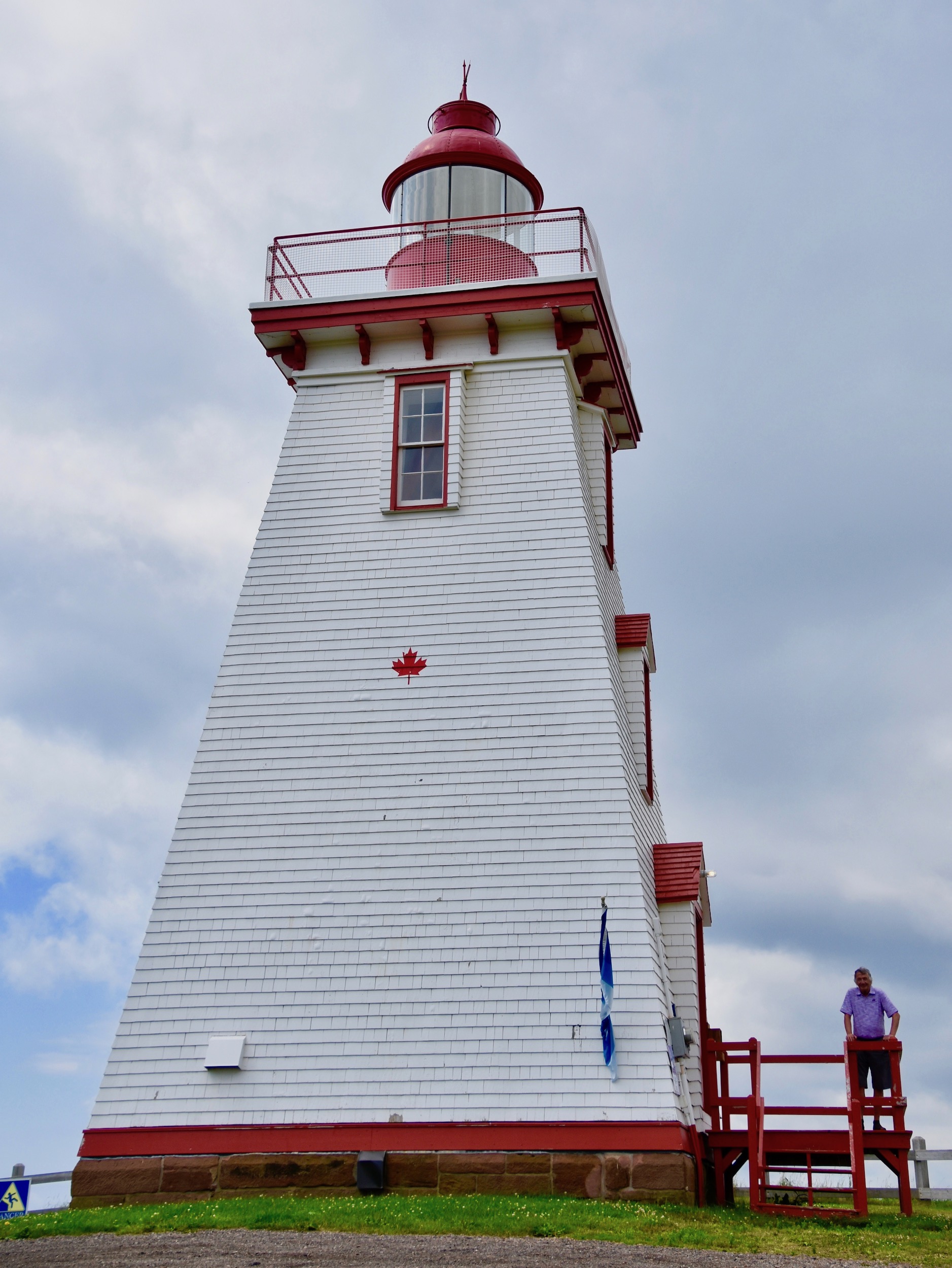
Anyone who is a regular reader of my posts knows that I’m nuts about lighthouses and never pass up a chance to visit one. Already on this trip we have stopped at North Cape lighthouse which we found in a sad state of neglect and West Point lighthouse which is now being used as an inn. Our next lighthouse is in Souris which sits high on a bluff called Knight Point and is open to the public. As you can see this lighthouse is in fine fettle and lovingly cared for by the local historical society. While there is an admission fee, it is waived if you spend $20.00 in the gift shop which we had no problem doing.
Inside the lighthouse there are a couple of very interesting collections. The first is beach glass with samples of dozens of different kinds and explanations of their various degrees of rarity.
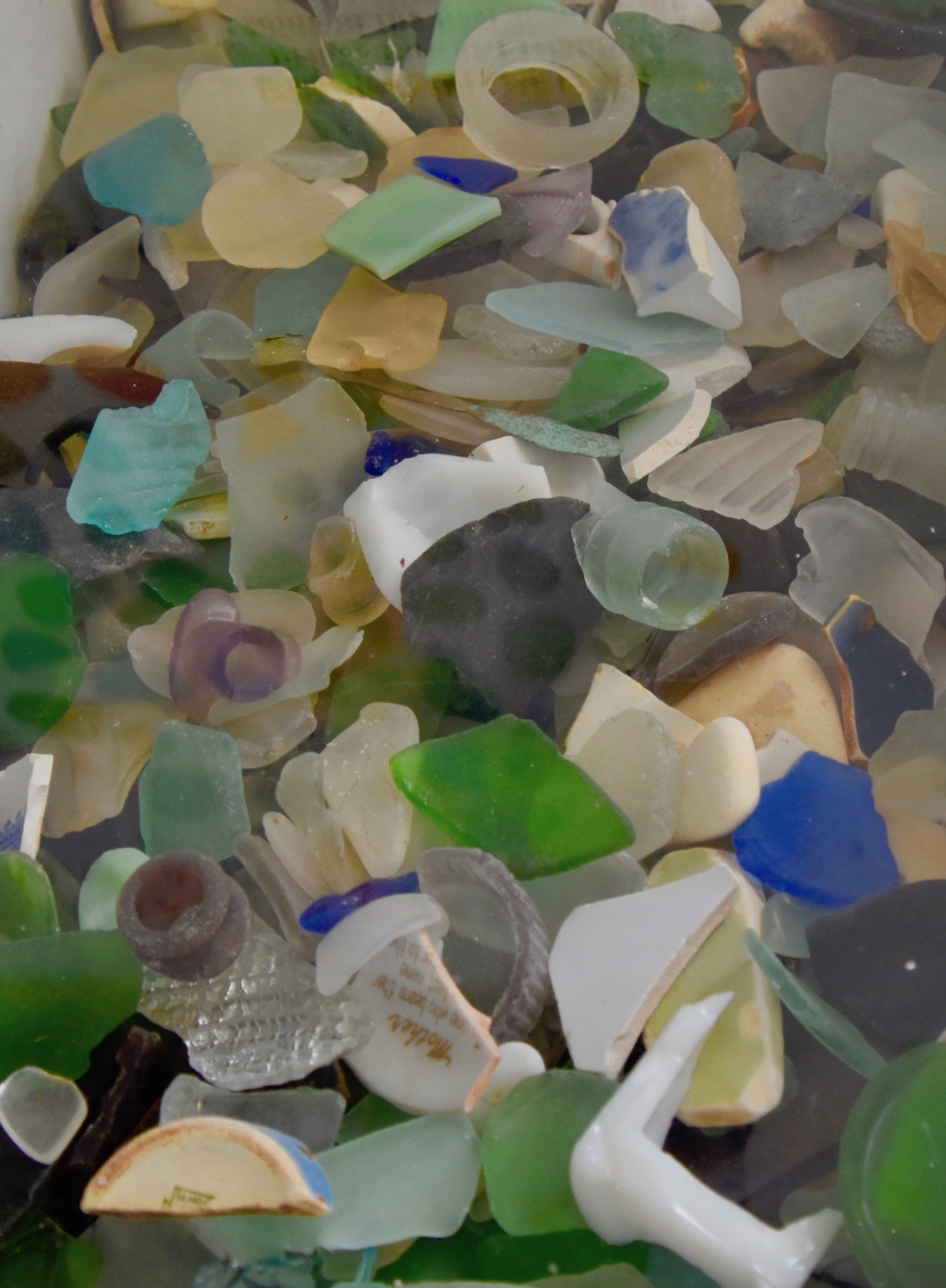
The second are samples of sand from beaches all over the world. We were pleasantly surprised to see a sample of the black sand from Ometepe Island in Lake Nicauragua which we had been standing on way back in February, before the world changed.
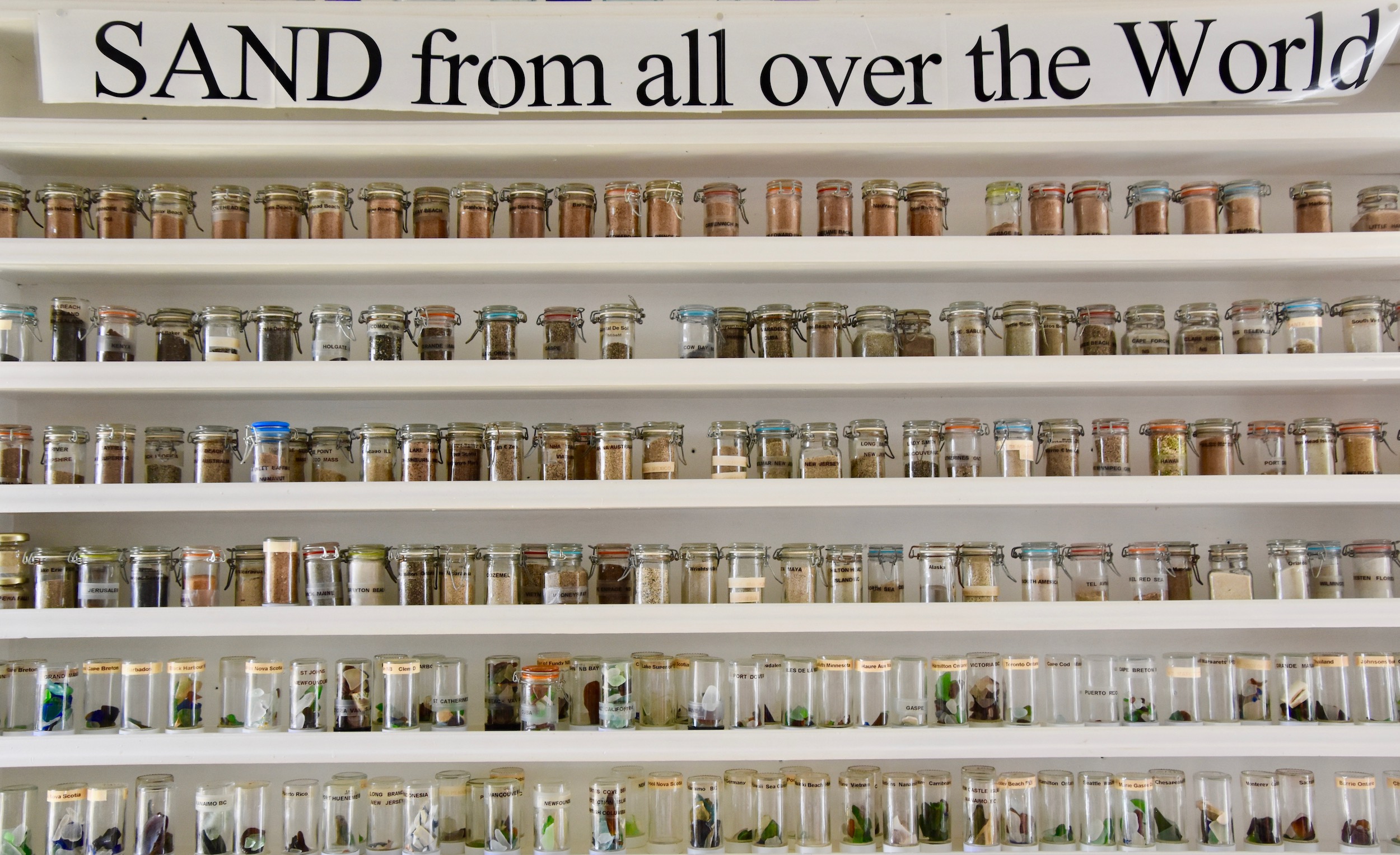
The payoff in visiting these lighthouses is always the view from the top and the Souris lighthouse is no exception.
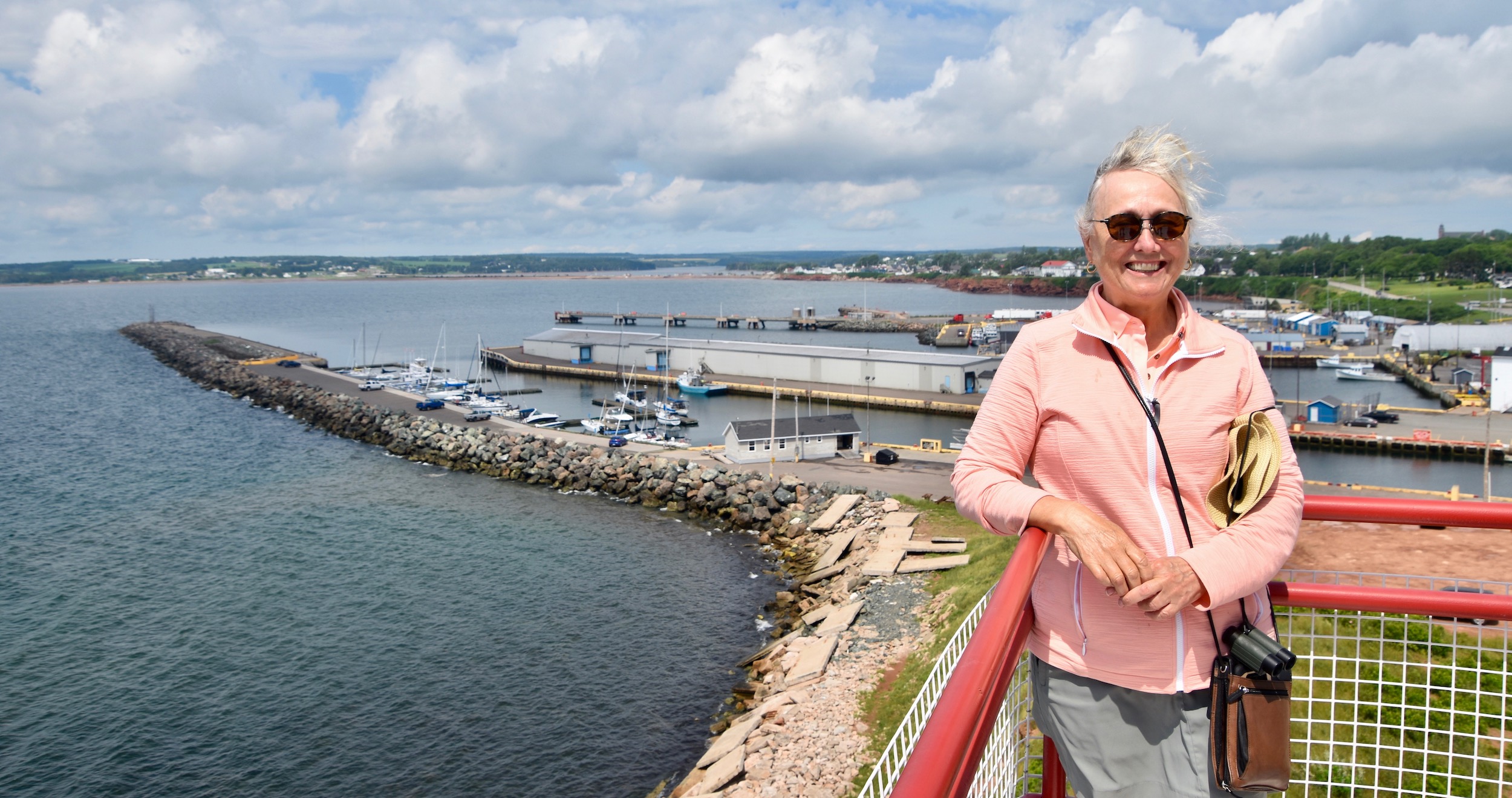
Basin Head, Eastern PEI
Leaving Souris, we continued our exploration of eastern PEI by heading for Basin Head which has both an acclaimed fisheries museum and one of the most popular beaches on the island.
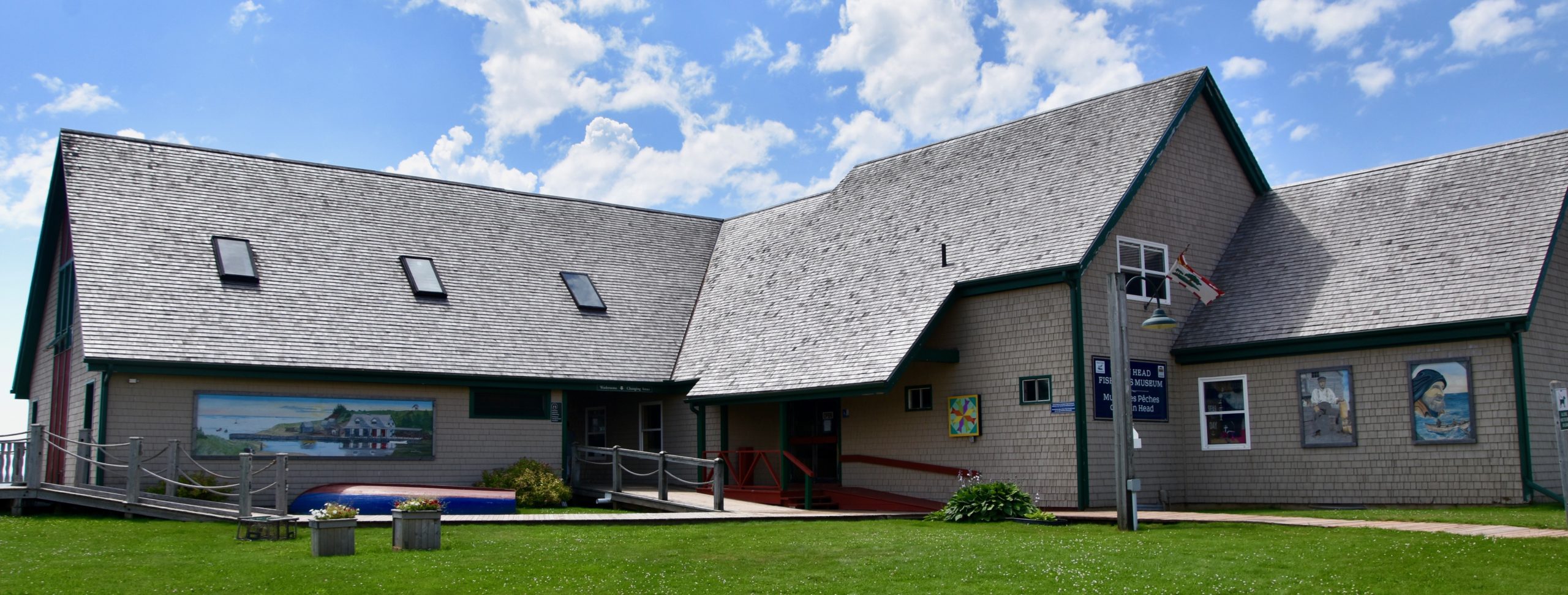
There was a time in PEI that if you were not a farmer or a forester then you were almost certainly a fisherman and that would entail many different types of fishing depending on the time of year or the locale. The Basin Head Fisheries Museum goes to great lengths to demonstrate to its visitors each of these various types of fisheries as they were practised both historically and in the present day. Due to Covid restrictions you must take a guided tour and as we were the only visitors we had our own private tour with our very informative guide, Georgia.
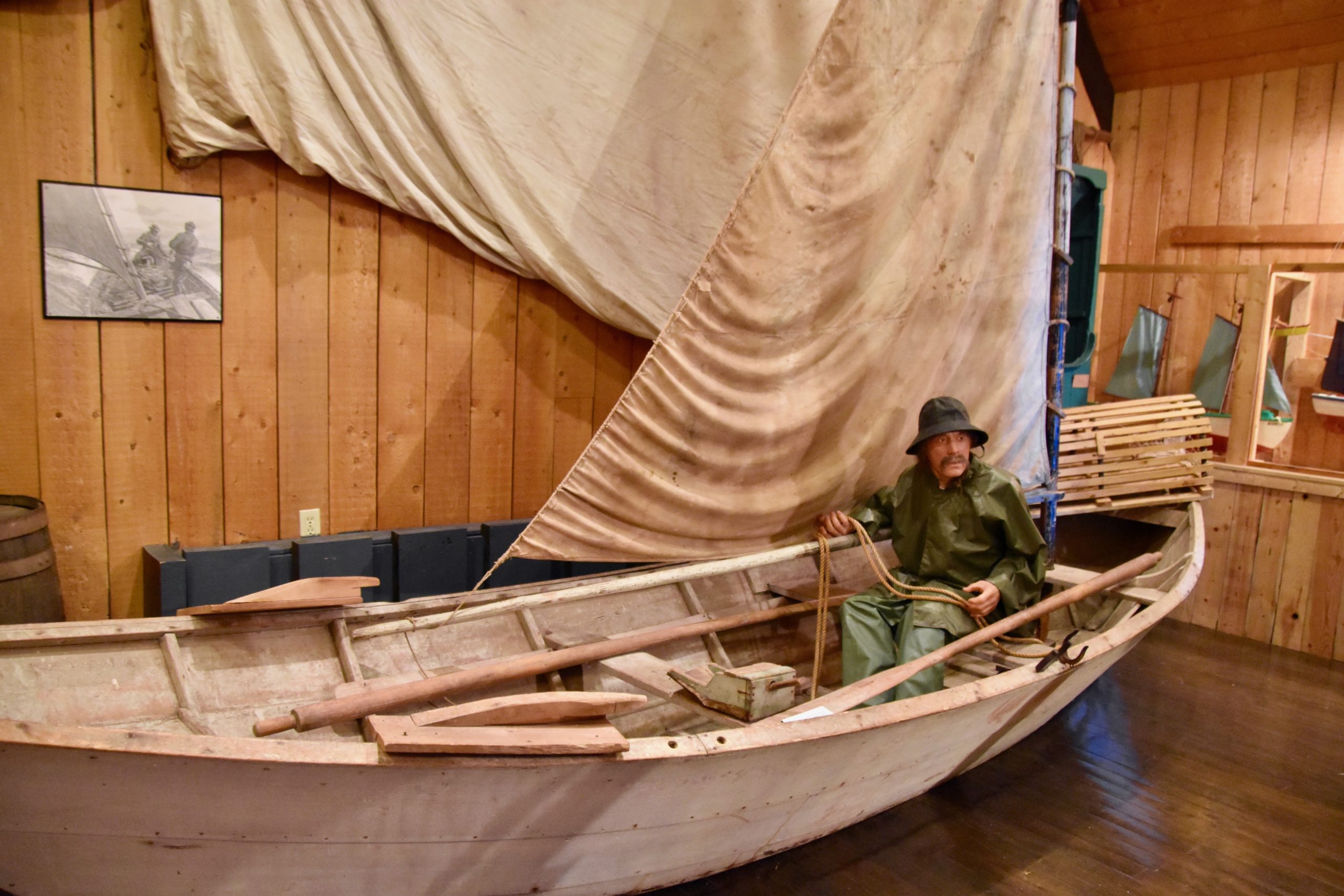
This is a very realistic depiction of a dory fisherman who would be put out on the open sea from a larger boat and jig for cod, haddock and halibut until the boat was full and then row back to the mother ship. It was back breaking and dangerous work that was still practiced on the Grand Banks and other places around Atlantic Canada until well into the 20th century. Dorys could also be used for inshore fishing with the fisherman rowing out from shore to the fishing grounds.
The museum has many very interesting dioramas which are themselves works of folk art. Each depicts a different aspect of fishing in PEI. Here are a few examples starting with scallop dragging from small Cape Islander boats.

This is herring fishing which was done with a net from a dory to get the bait necessary for lobster traps.
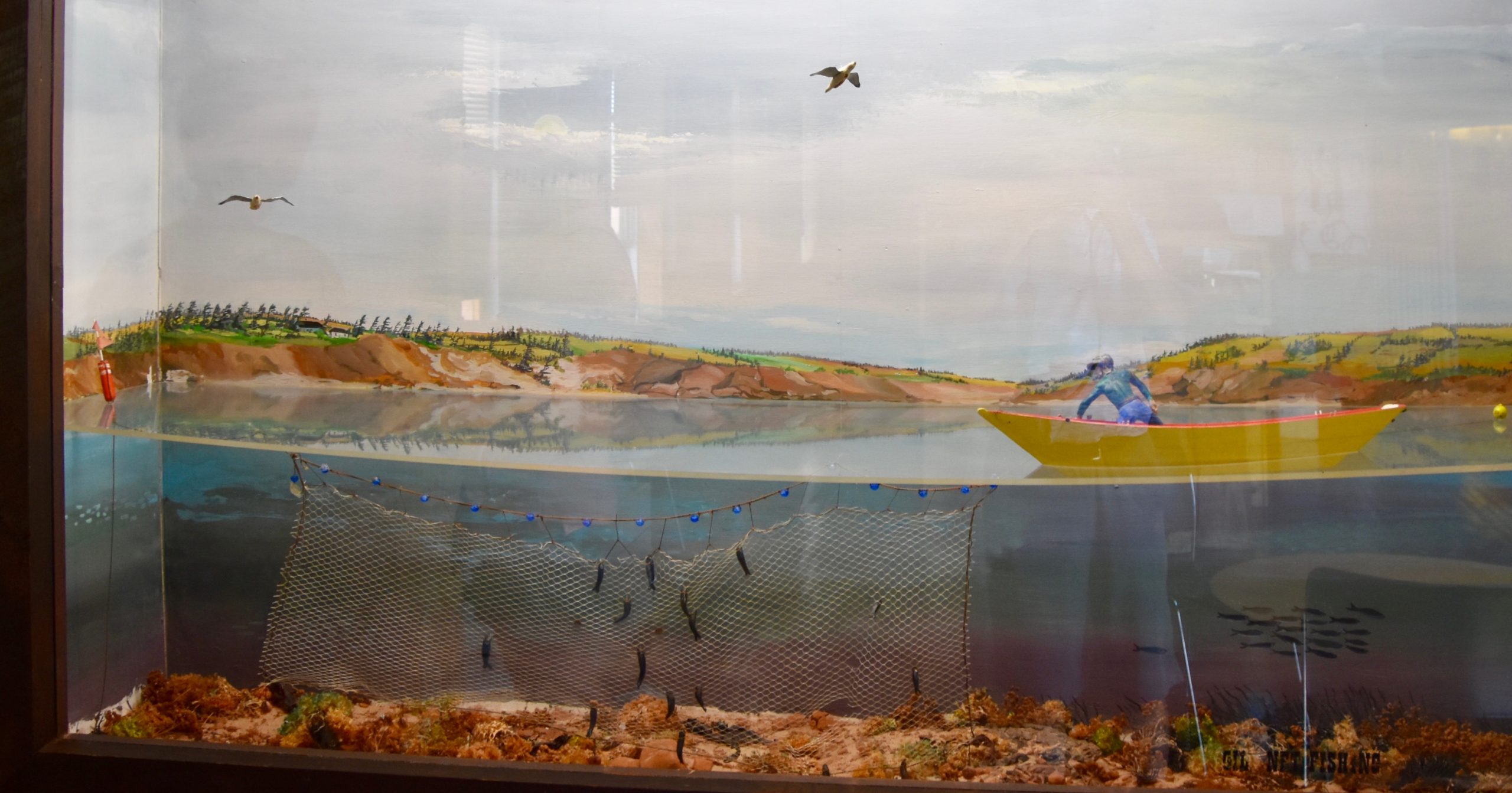
And this is how they once raked for wild oysters.
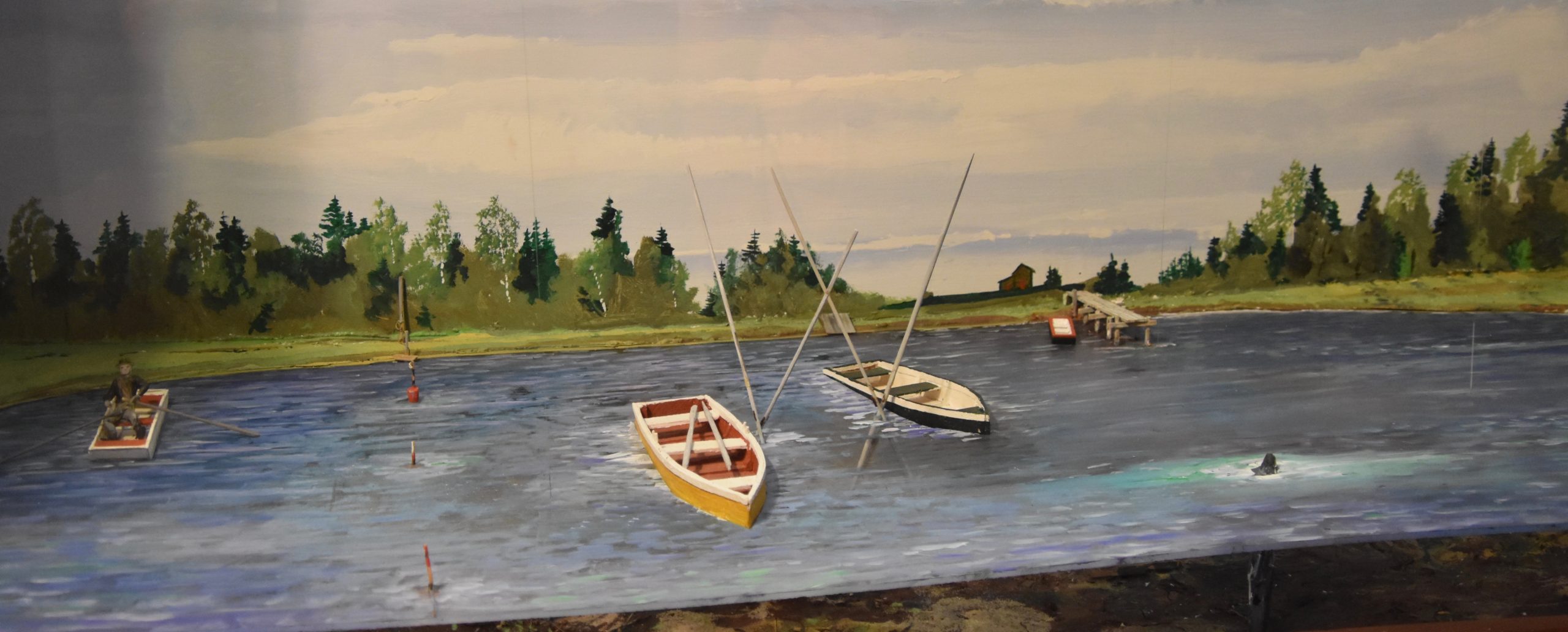
There is a great deal of detail in these dioramas and reason alone to visit this fine museum, but there is much more like this depiction of the bluefin tuna fishery which involves one man and a giant fish. Georgia explained to us that in order to prevent the meat from spoiling it was necessary to slowly tire out these fish rather than haul them in as quickly as possible. The flesh of the bluefin is the most expensive of any of the types of tuna used in sashimi and sushi. There is still a flesh grader from Japan on duty in PEI during the fishing season who oversees the packing in ice and shipment of these fish to the world’s largest fish market in Tokyo.
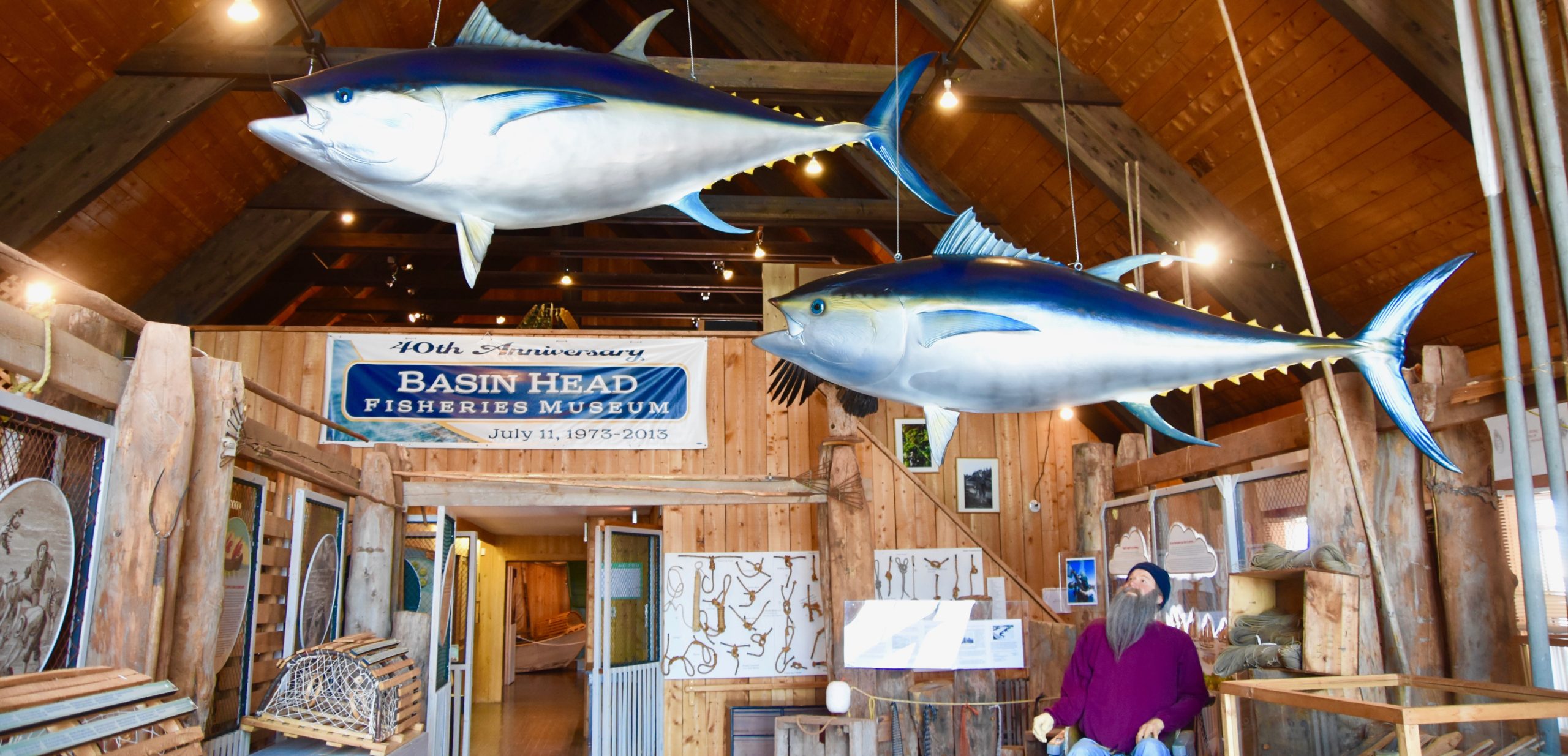
My last photo from the Basin Head Fisheries Museum is of a portion of the buoys and floats collection.
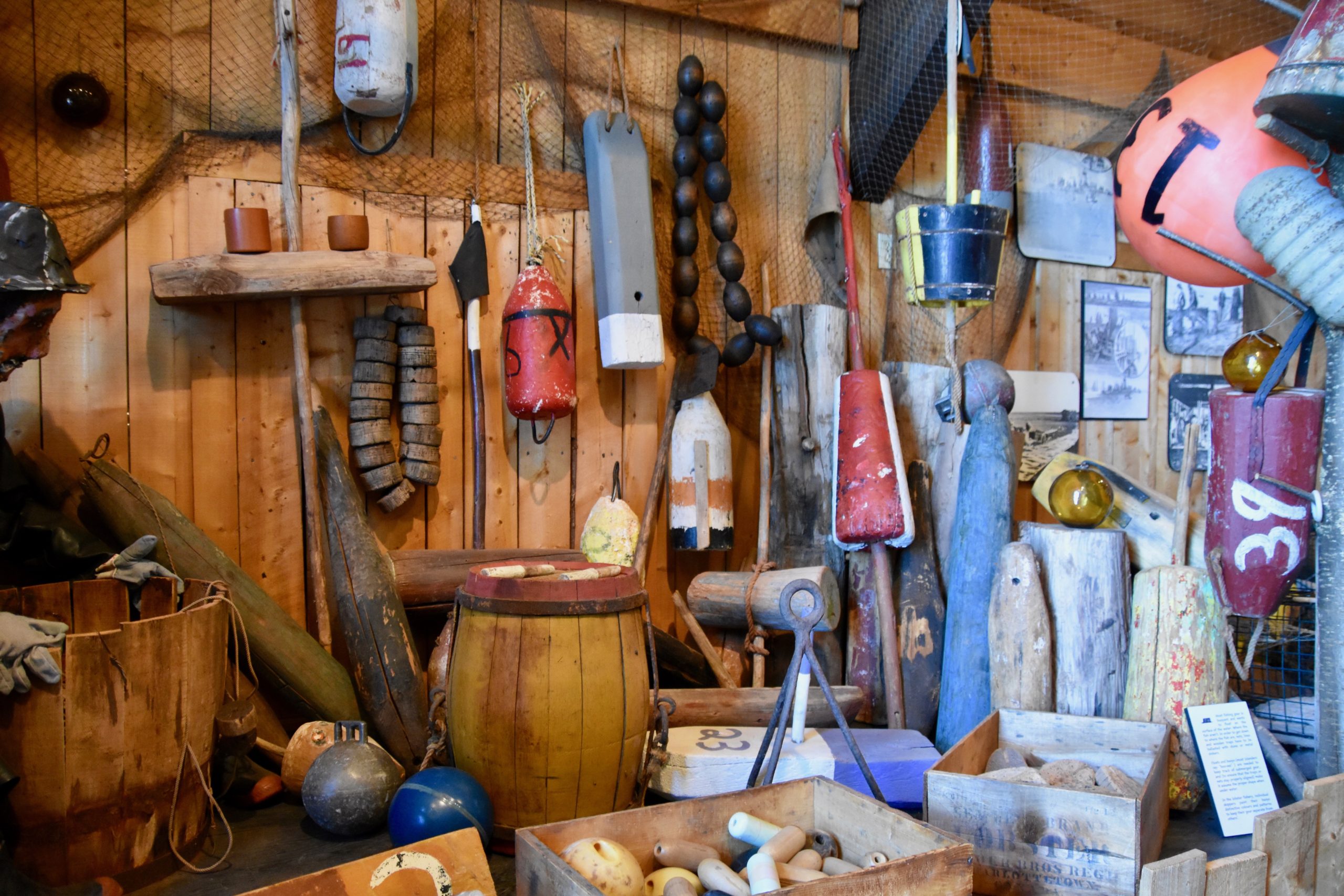
Leaving the museum we grabbed ice cream cones from one of the many small businesses that rely on the summer beach traffic for their livelihood. Sadly, many were closed and a lifeguard told us that pre-Covid they would average 500 cars a day and on some days up to 1,000. Now as you can see from this photo the beach is almost deserted despite it being an absolutely perfect day to go to the beach. As I write this, there is still lots of summer left and if you like PEI’s famous beach. but are leery of the crowds, then this is the year to visit.
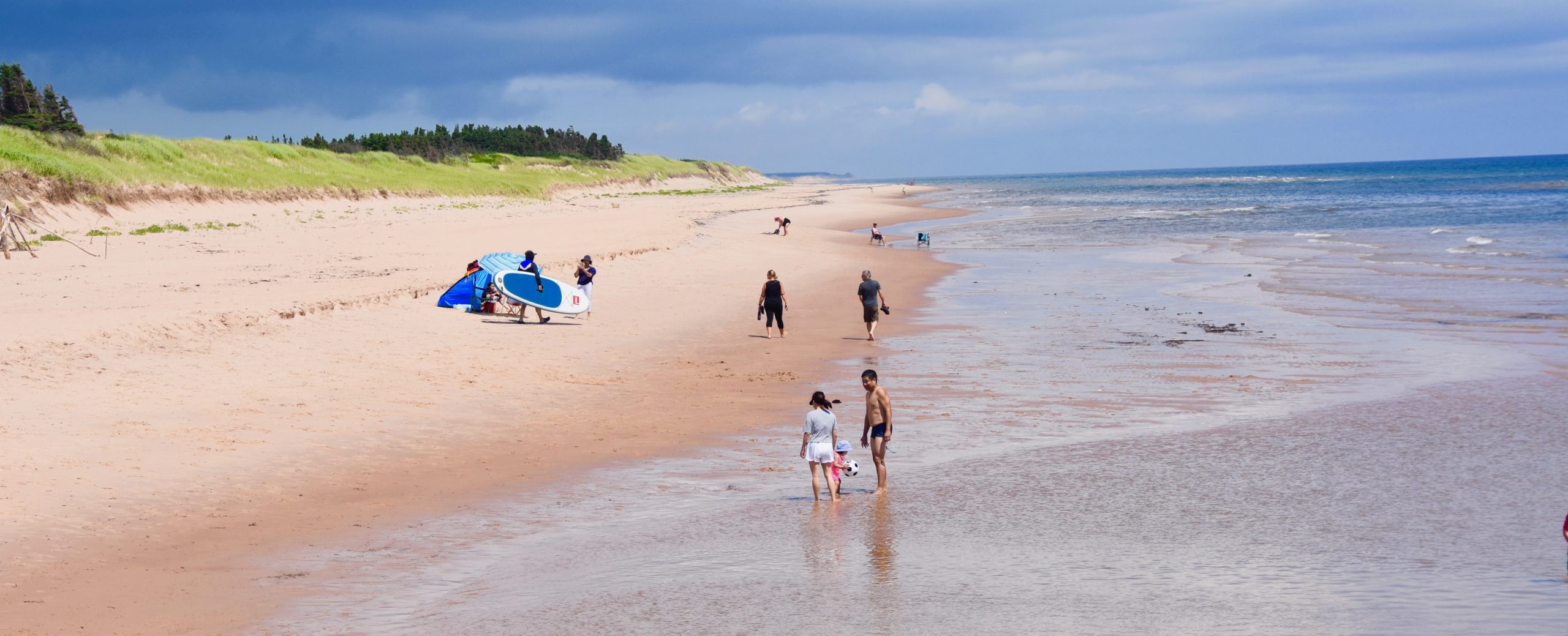
One of the highlights of visiting this beach over many others in eastern PEI is that you can enter the water upstream from the beach in the small river that drains into Basin Head and then float with the current through this manmade channel and out to the small sandy bar.
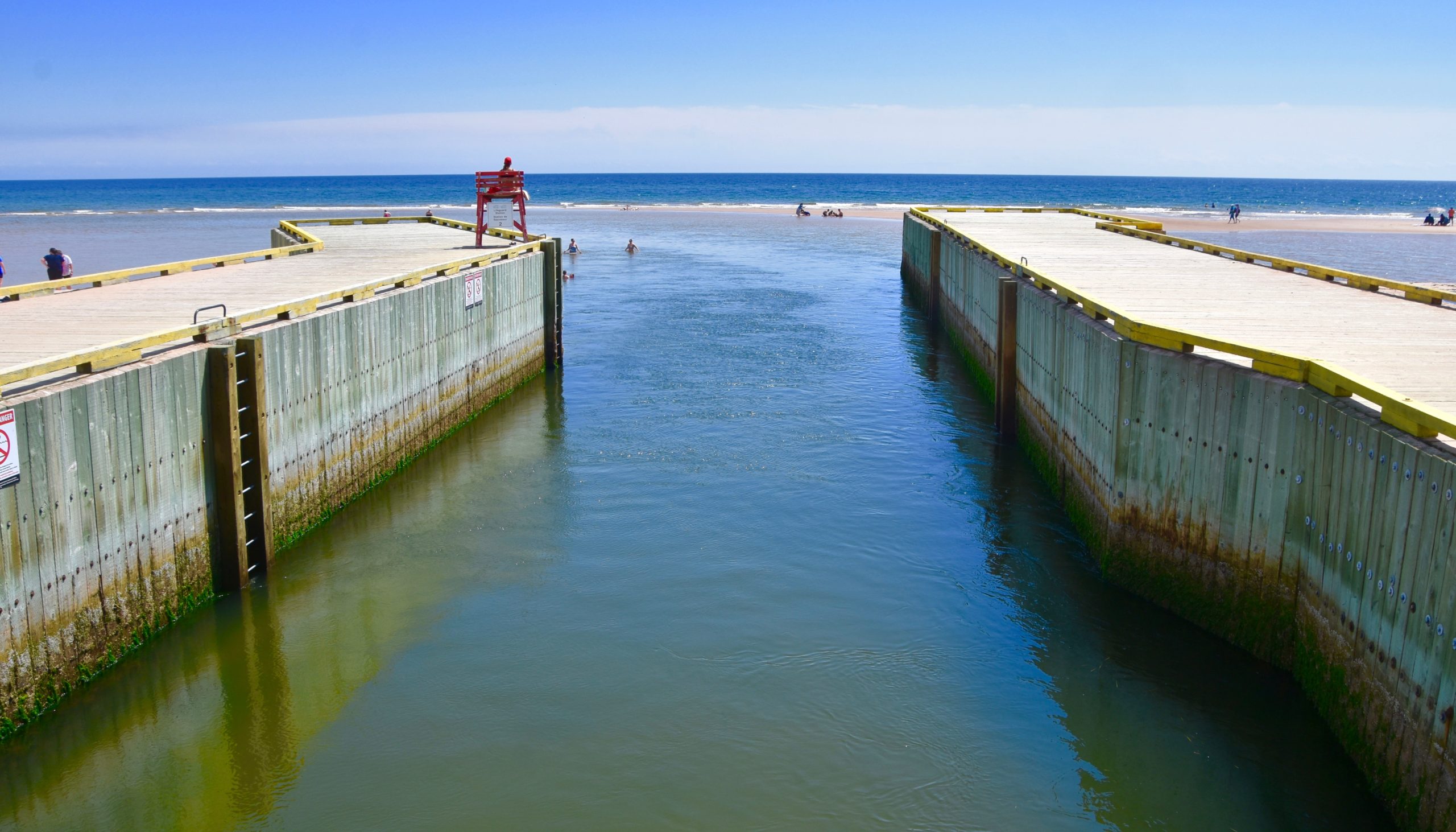
East Point Lighthouse, Eastern PEI
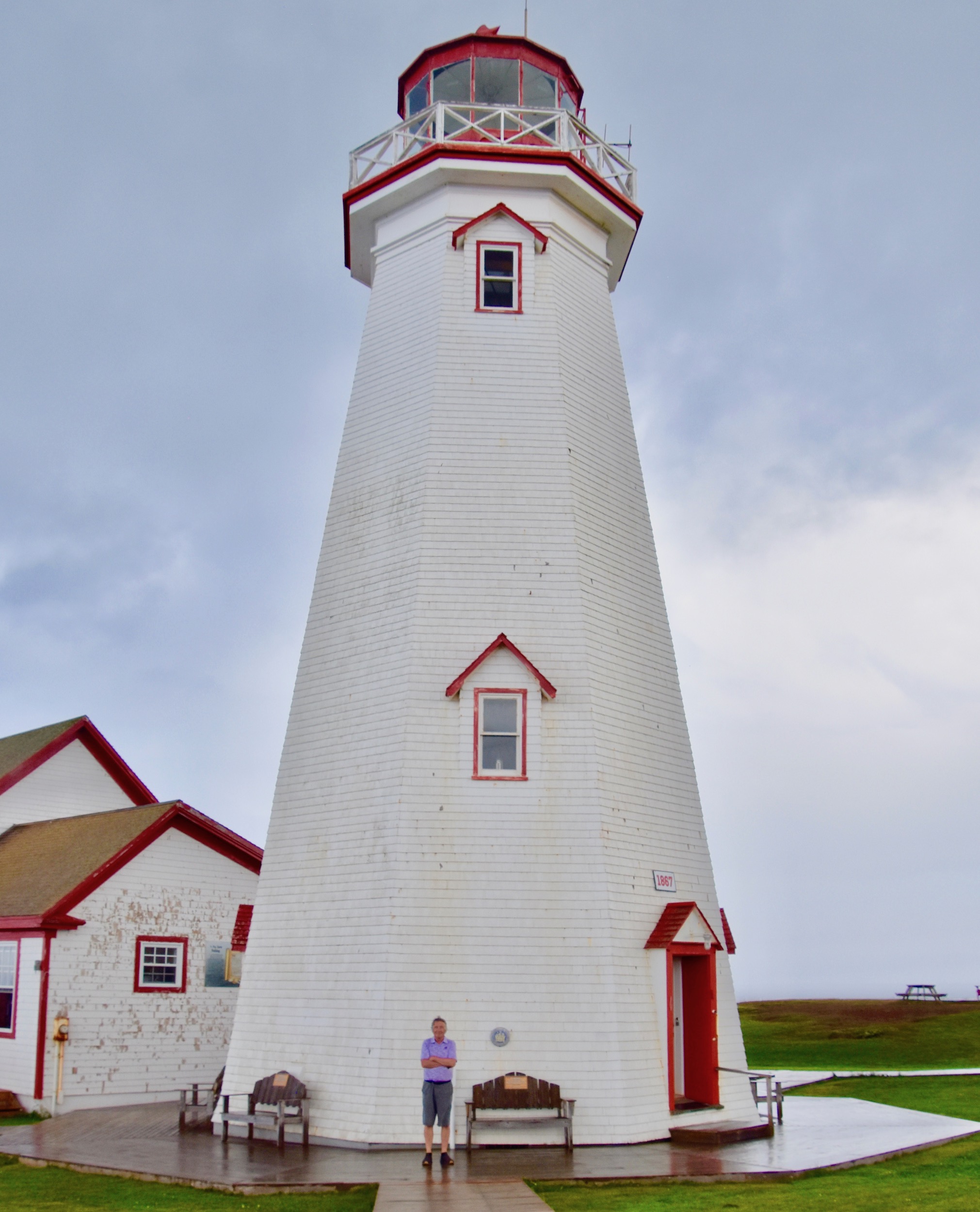
Our final stop on this whirlwind tour of eastern PEI is the lighthouse on the most easterly point on the island, East Point Lighthouse which doubles as “Canada’s Confederation Lighthouse”, being the only one built in 1867 that is still in operation. We’ll overlook the fact that PEI did not join confederation until 1873. At 64 feet it’s impressively tall and worth the price of admission to climb. Unfortunately it fogged up just before out visit so I don’t have a useable photo from the top. I do remember very well passing this light on the ferry to the Magdalen Islands as it rounded the tip of eastern PEI and it was the last thing in sight as The Gentle Island faded from sight over the horizon. And on that note I’ll end this post and invite you to join us at Greenwich Dunes in the next post.

